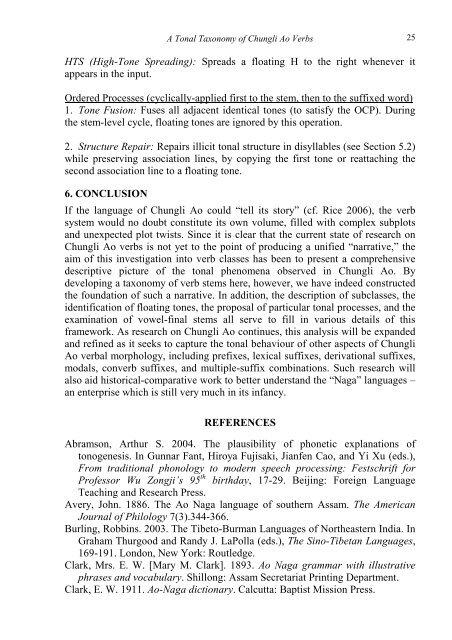A TONAL TAXONOMY OF CHUNGLI AO VERBS Daniel Bruhn ...
A TONAL TAXONOMY OF CHUNGLI AO VERBS Daniel Bruhn ...
A TONAL TAXONOMY OF CHUNGLI AO VERBS Daniel Bruhn ...
Create successful ePaper yourself
Turn your PDF publications into a flip-book with our unique Google optimized e-Paper software.
A Tonal Taxonomy of Chungli Ao Verbs<br />
HTS (High-Tone Spreading): Spreads a floating H to the right whenever it<br />
appears in the input.<br />
Ordered Processes (cyclically-applied first to the stem, then to the suffixed word)<br />
1. Tone Fusion: Fuses all adjacent identical tones (to satisfy the OCP). During<br />
the stem-level cycle, floating tones are ignored by this operation.<br />
2. Structure Repair: Repairs illicit tonal structure in disyllables (see Section 5.2)<br />
while preserving association lines, by copying the first tone or reattaching the<br />
second association line to a floating tone.<br />
6. CONCLUSION<br />
If the language of Chungli Ao could “tell its story” (cf. Rice 2006), the verb<br />
system would no doubt constitute its own volume, filled with complex subplots<br />
and unexpected plot twists. Since it is clear that the current state of research on<br />
Chungli Ao verbs is not yet to the point of producing a unified “narrative,” the<br />
aim of this investigation into verb classes has been to present a comprehensive<br />
descriptive picture of the tonal phenomena observed in Chungli Ao. By<br />
developing a taxonomy of verb stems here, however, we have indeed constructed<br />
the foundation of such a narrative. In addition, the description of subclasses, the<br />
identification of floating tones, the proposal of particular tonal processes, and the<br />
examination of vowel-final stems all serve to fill in various details of this<br />
framework. As research on Chungli Ao continues, this analysis will be expanded<br />
and refined as it seeks to capture the tonal behaviour of other aspects of Chungli<br />
Ao verbal morphology, including prefixes, lexical suffixes, derivational suffixes,<br />
modals, converb suffixes, and multiple-suffix combinations. Such research will<br />
also aid historical-comparative work to better understand the “Naga” languages –<br />
an enterprise which is still very much in its infancy.<br />
REFERENCES<br />
Abramson, Arthur S. 2004. The plausibility of phonetic explanations of<br />
tonogenesis. In Gunnar Fant, Hiroya Fujisaki, Jianfen Cao, and Yi Xu (eds.),<br />
From traditional phonology to modern speech processing: Festschrift for<br />
Professor Wu Zongji’s 95 th birthday, 17-29. Beijing: Foreign Language<br />
Teaching and Research Press.<br />
Avery, John. 1886. The Ao Naga language of southern Assam. The American<br />
Journal of Philology 7(3).344-366.<br />
Burling, Robbins. 2003. The Tibeto-Burman Languages of Northeastern India. In<br />
Graham Thurgood and Randy J. LaPolla (eds.), The Sino-Tibetan Languages,<br />
169-191. London, New York: Routledge.<br />
Clark, Mrs. E. W. [Mary M. Clark]. 1893. Ao Naga grammar with illustrative<br />
phrases and vocabulary. Shillong: Assam Secretariat Printing Department.<br />
Clark, E. W. 1911. Ao-Naga dictionary. Calcutta: Baptist Mission Press.<br />
25

















